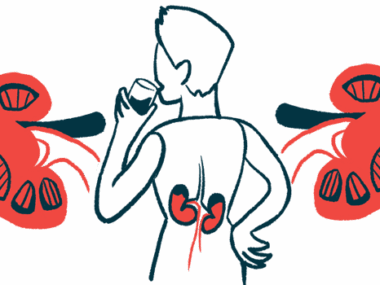My worst fear has become a regular part of my life with aHUS
Twice-monthly needle sticks, though necessary, still unnerve me
Written by |

Note: This column was updated Jan. 16, 2025, to correct that Soliris is an antibody therapy.
The snap of a nitrile glove going on my nurse’s hand catches my attention and diverts my gaze from my phone. I see her holding a butterfly needle as she prepares to give me my second stick of the day. My heart rate quickens and my body tenses at the thought of the impending piercing pain. I unconsciously hold my breath as the needle inches toward my skin. Hopefully she doesn’t miss my vein, as most of my nurses have done, which leads to multiple sticks.
I deal with this anxiety every 14 days, and I have a lifetime of it ahead of me.
I’ve hated needles as long as I can remember. As a small child I was so terrified of shots that I tried to hide from my parents before doctor appointments. When I gave birth to my children, I wasn’t scared of being cut open for a cesarean section; I was scared to have IVs and spinal anesthesia.
But my fear of needles wasn’t unfounded. I’ve always been the queen of bad medical luck. Nurses often miss my veins for blood draws, and one time a needle broke off in my arm when I was immunized in middle school.
I also had a horrendous experience with injections during my first C-section. I’d told myself if I could make it through the IV and spinal, the worst would be over. It took nine attempts from two anesthesiologists to place my spinal correctly. That meant nine shots of numbing medicine and nine spinal attempts, for 18 total injections. My experience was so awful that I learned five years later that I’m still discussed at anesthesiologist conferences.
The advent of aHUS
Fast forward to September 2020, when I became gravely ill after months of a slow decline. I’d stalled on going to the doctor because of my intense fear of needles, as well as a lack of insurance. But I was ultimately admitted to the intensive care unit because I was dying from a rare disease called atypical hemolytic uremic syndrome (aHUS).
Even though I faced death, I could only focus on the needle sticks. It took weeks before I was diagnosed. But to get there, I had to undergo lots of blood draws, about three to six a day. My rare disease causes hemolytic anemia, so drawing blood was more complicated than usual because I was missing so much of it. Red blood cells were being destroyed faster than my body could produce them.
Eventually my nurses ran four IV leads in my arms so they could try to pull blood from those. Each and every IV or blood draw left huge, dark purple bruises all over my body. I looked awful. But each IV would eventually get gummed up with my thick blood and would in time stop working, so I needed new IVs every couple of days.
Once I received my diagnosis, I was able to begin treatment with the antibody therapy drug Soliris (eculizumab.) This medicine was administered through one of my existing IVs. But once I left the hospital two months later, I no longer had those IVs set up for antibody therapy.
Every time I go to antibody therapy now, blood is drawn and an IV run for the treatment. That’s every 14 days. I’ve been on this schedule for three and a half years now. To make matters worse, I developed May-Thurner syndrome as well, which makes my entire left side swell nearly all the time. That’s made my left arm useless for blood draws or IVs.
Medical staff attempted to use the swollen arm for weeks before coming to that conclusion, leaving me with a blown vein and useless needle sticks. Now my right arm is the only one used for injections.
I have the option of getting a permanent port access placed in my chest or arm. But when I had a port catheter for dialysis, I had so many complications. Two infections led to the port’s removal and replacement. And one night, my port simply fell out of my chest.
A permanent port is mostly internal and is safer then a port catheter, but having one put a bad taste in my mouth. The experience was so painful and traumatizing that I just can’t do it again. With my proclivity to medical mishaps, I feel that a port is just another problem waiting to happen.
I never thought I’d choose to have needles poked in my arm every other week. But the anxiety of four needle sticks a month seems less stressful than a permanent port. I have a lifetime of sticks ahead of me, but those needles are giving me a chance at having a life to live.
Note: aHUS News is strictly a news and information website about the disease. It does not provide medical advice, diagnosis, or treatment. This content is not intended to be a substitute for professional medical advice, diagnosis, or treatment. Always seek the advice of your physician or other qualified health provider with any questions you may have regarding a medical condition. Never disregard professional medical advice or delay in seeking it because of something you have read on this website. The opinions expressed in this column are not those of aHUS News or its parent company, Bionews, and are intended to spark discussion about issues pertaining to aHUS.






Leave a comment
Fill in the required fields to post. Your email address will not be published.